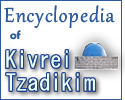Kivrei Tzadikim
Kevarim of Tzadikim, Tombs, Holy Places, Graves of the Righteous, Graves of Tzaddikim.
Contents |
[edit] No Decaying
Tzadikim that were perfect in this world and were fully Shomer Habris, their bodies do not decay after they pass away. There are a few cases where Kevarim of Tzadikim were transferred in recent years and the workers saw the bodies fresh as they day they passed away.
[edit] Praying
It is auspicious to pray at Kevrei Tzadikim and prayers done there are more likely to get answered.
[edit] Formalities
[edit] Mikva
It is important to purify oneself by immersing in a Mikva before visiting Kivrei Tzadikim, this is especially true if a person has experienced an emission. If a person can not immerse in a Mikva he should try to do a mikvah alternative such as Tisha Kavim or Nitalas Yadaim 40 times. Even if a person can not do the above he should still visit the Kevarim of true Tzadikim and rely on their power to cleanse him. This is only true in cases where the Tzadik is buried alone like the Rashbi, however in cases where a person has to first pass through a cemetery filled with less then holy bodies, one should avoid doing so without immersing in the Mikva.
[edit] Studying Torah
Torah studied at the grave of a Tzadik is valued many times over Torah studied elsewhere. It is customary to study actual teachings innovated or taught by the Tzadik himself or in reference to him or the essence he represented. It is known that when a person recites a teaching in the name of a Tzadik, his lips move in the kever, this is especially true if done at that very location.
[edit] Tehilim
It is very common for people to recite Tehilim at Kivrei Tzadikim especially the ten chapter of the Tikkun HaKlali.
[edit] Stepping on Graves
[edit] Lighting Candles
[edit] Burial Strategy
[edit] In Galil
During the early times of the Mishna and Talmud, many Tzadikim were brought up North to be buried. Although the trip sometimes took 2-3 days this was done to establish holiness into the Galil, something which the Yerushalaim area naturally had due to the Bais Hamikdash.
Additionally the traditions of the Kabbalah reveal that the resurrection of the dead will begin in the Galil, giving many of the Sages, the desire to be buried there so they can be among the first resurrected.
[edit] From Bavel
Many Tzadikim were brought up from Babylon to be buried in Eretz Yisroel, a trip that often took a few weeks. Sometimes these Tzadikim were brought up right after their passing. Other times they were temporarily buried locally and were transferred at a later point.
[edit] Far Out
Often Tzadikim were buried in the places where they used to study Torah and do Hisbodedute and meditations. These locations were often far out from civilization to avoid disturbances, explaining why some kevarim are in middle of nowhere. Additionally kivrei tzadikim were often planted in strategic locations across the country to provide protection and implant holiness on their surrounding areas. There are also instances where the area of the kever was inhabited 2000 years ago but has become abandoned throughout history.
[edit] Near Roads
Sometimes Tzadikim were buried near main roads so they could be visited by all the travelers passing by. Since many roads in Northern Israel have changed little since Roman times, as can be attested to by their many turns and curves, these Kevarim are found on the roadside till this day.
[edit] Moving Kevarim
In recent time a number of kevarim were moved from Diaspora to Eretz Yisroel including Rabbi Chaim Vital and the Chida.
[edit] Empty Kivarim
Since grave robbery was a common problem throughout history, often Kivarim were created with a fake empty 'Kuch' on top while the actually body was buried a level under this. Grave robbers would then assume the tomb had already been vandalized and would leave it alone. A typical example of this is the Cave of Hillel the Elder, where empty caskets lay above the actual Kivarim.
[edit] Historical
A number of Midrashim relate the importants of Kivrei Tzadikim. Kalev ben Yefuneh went to pray in Chevron on his spying trip to Eretz Yisroel so he would be saved from the plot of the Miraglim. It also states that the kever of Moshe was hidden from man since Hashem knew that any decree including that of the exile could be annulled if people came and prayed by his kever. This is also the reason why Yackov, buried Rachel in middle of the road leading from Efrasa. He foresaw with Roach Hakodesh how his descendant would be exiled along this route following the destruction of the First Temple and passing would allow them the opportunity to pray and have Rachel intervene for Divine mercy.
[edit] Tziyun Vs. Kever
Sometimes the exact location of the Kevarim are known. Other times the exact location is unknown. In these cases a Tziyun or marker Kever is created in the rough estimated location of the actual grave. Even if the Tziyun is not located exactly on the grave the soul of the Tzadik comes to dwell there once the location is accepted by the masses.
[edit] Organizations
[edit] Kadmonanue
Vaad Hatzalos Kevrei Hakadmonim
[edit] Yisroel Meir Gabbai - Ohalei Tzadikim
[edit] Misrad Hadatot
Israeli Government Department of Religion - Mercaz Hartzi LiPituach Mekomas Hakedoshim - The Holy Sites Authority.

